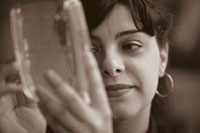The Laws of Physics - Making of a Teacher
A close look at teacher preparation through the eyes of six students during a semester at Teachers College
It's just after eight on a freezing morning in early March, and Talia Javid is dumping Tupperware containers of yellow and orange gelatin slices out on a table at Bayside High School in Queens. She's commuted two hours to get here, but Talia, a master's student in secondary science education at Teachers College, is wired. Soon she'll be leading an eleventh-grade Regents physics class through an experiment that demonstrates how refraction works.
"Light bends when it passes through a medium that changes its speed," she tells me as she rushes through her set-up. "We'll demonstrate that by shooting lasers through the gelatin and measuring the angle of the light." She shrugs. "I looked it up online and said, 'Wow, I wonder if I can do this with Jell-O Jigglers?' It's not the most scientific experiment, but if it works, they should see the light bend immediately."
At 24, Talia, a petite, dark-eyed woman with an appealing, slightly scattered manner, looks barely older than some of her students. But she's all business once the bell sounds.
"Desks together, guys," she calls, clapping her hands. "Come on, now--you're supposed to be in groups."
She makes the rounds, putting out small fires: a kid trying to eat his Jell-O slice, boys harassing girls with their lasers, an entire group sitting idle because no one remembered to bring a protractor.
Talia is one of 10 students attending TC through a $50,000 Petrie Fellowship. Under its terms, she has pledged to teach in New York City public schools for at least five years after earning her degree, foreswearing the higher pay that usually comes with jobs in the suburbs. As a physics teacher, she'll be in high demand, even though many schools in New York City don't even offer the subject.
Still, she's happy with her choice. Even as a teenager back in Poolsville, Maryland, where she attended a special environmentally-themed science high school, Talia was saving her money to some day live in New York City. That was when she read Fritjof Capra's The Tao of Physics, which links the modern principles of Einstein, Heisenberg, Bohr and others to the mysticism of Buddha and Lao Tzu.
"I didn't understand it, but physics seemed like one of the most interesting things you could learn about," she says.
She graduated with a physics degree from the University of Maryland at College Park, temped in a teen pregnancy prevention center in Washington, D.C., and then was hired full-time as the center's communications director. Talia quickly discovered that her real love was designing activities for the young women.
"None of them liked science or math, but that was because they'd never been given the chance," she says. "I decided I wanted to make people who thought they didn't like science enjoy it and want to do it."
Hands-on, Minds-on
In many ways, those words aptly summarize TC's philosophy of teaching. The TC ideal, says Assistant Professor of Science Education Keith Sheppard, is "hands-on, minds-on science," aimed at leading students to discover fundamental truths through questions and activities rooted in everyday life.
Talia's Jell-O experiment, for example, illustrates Snell's Law (the index of refraction for air times the sine of the angle of incidence equals the index of refraction for gelatin times the sine of the angle of refraction), which governs the workings of just about every optical device on the planet--including the human eye.
The teacher functions more as a coach than a top-down authority. The focus is on group activities, with students setting the classroom rules, so that expected behaviors--and punishments--become automatic. The key here is the word "ideal." Teaching of this kind can be something of a high-wire act. Kids can get out of control or come to class unprepared. Experiments can go technically awry, or simply fall flat.
Thus students in TC's Student Teaching in Science seminar spend a lot of time honing their craft. One evening, two of Talia's classmates, Nick Pleskac and Sarah Petersen, drop stacks of quarters from different heights on nails embedded in a piece of wood to demonstrate how potential energy (quarters before they're dropped) can be converted into useful work (hammering in the nails). "To make this apparent, talk about experiences everyone's had," Pleskac advises the group. "Like when your mom drops her key ring out the window so you can let yourself in. From the second floor, catching the keys is no big deal. From the fourth floor, ouch, it hurts. And we've all been there."
Market Forces
In late May, Talia accepted a position for the upcoming school year at Central Park East (CPE), where she'd been doing her field placement during the second half of spring semester, teaching physical science. Earlier, she had been invited to tour another school that offers advanced placement physics classes and sends nearly all of its kids on to college. Though impressed, she found it "a little overly competitive." At CPE, classes are small and there's an emphasis on the use of portfolios-- compilations of student work--as an alternative to test scores. "In the end," she says, "you want to work someplace where you're comfortable."
Published Thursday, Nov. 17, 2005
